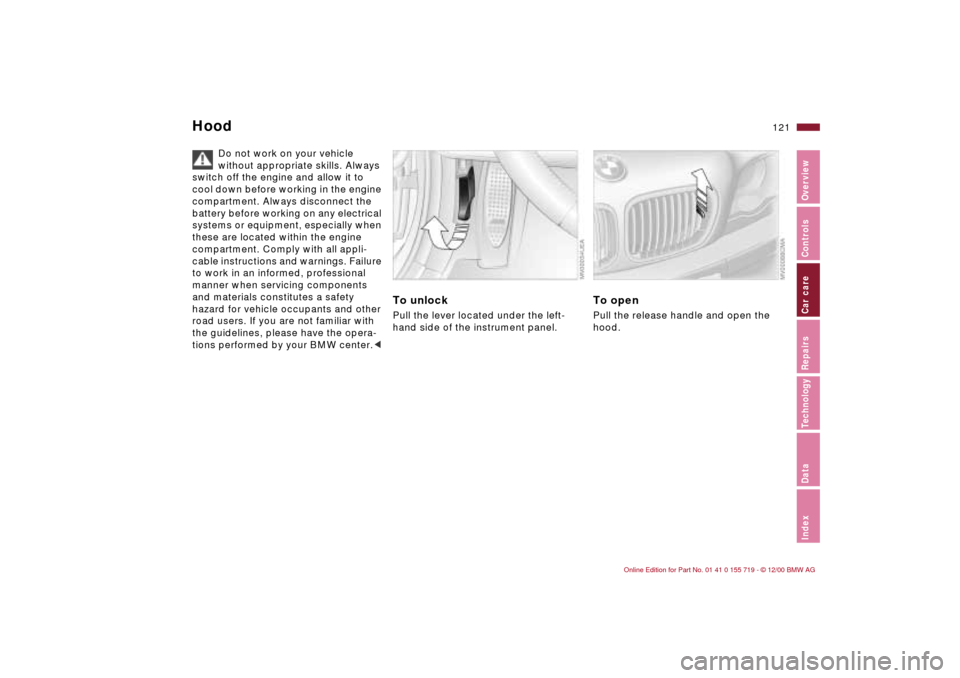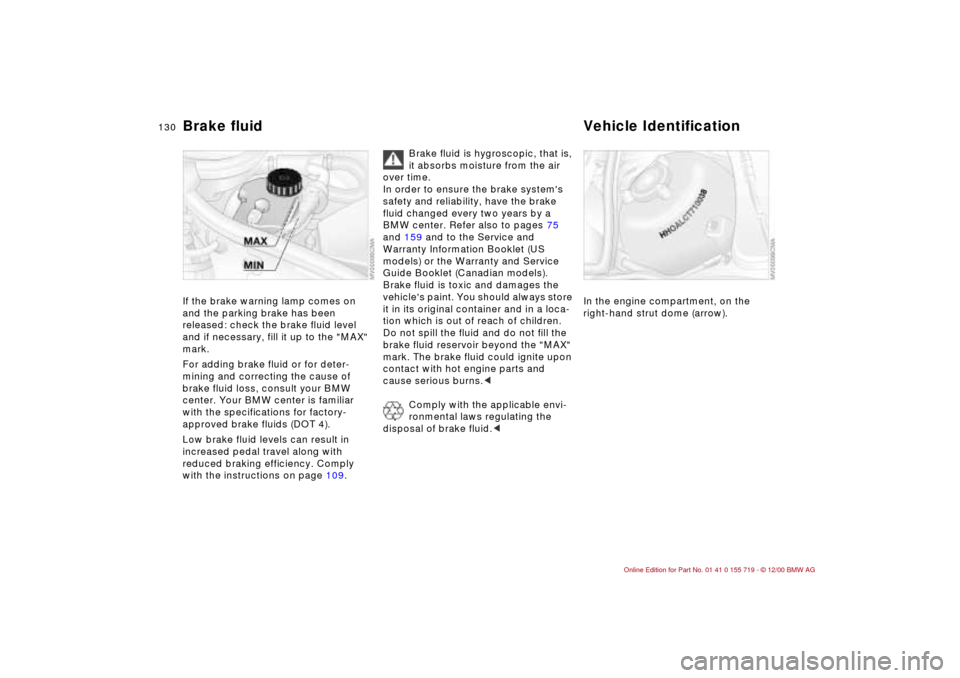2001 BMW M3 CONVERTIBLE warning
[x] Cancel search: warningPage 109 of 195

109n
IndexDataTechnologyRepairsCar careControlsOverview
Brake system Brake fluid level
If the brake warning lamp
comes on with the parking
brake released: the brake fluid
level is too low in the reservoir (refer to
page 130).
If the brake fluid level is too low and
brake pedal travel has become notice-
ably longer, there may be a defect in
one of the brake system's hydraulic
circuits.
Brake warning lamp for Cana-
dian models.
Proceed to the nearest BMW
center. Greater pressure on the
brake pedal may be necessary under
these conditions, and brake pedal
travel may be significantly longer.
Please remember to adapt your driving
style accordingly.<
Brake pads
If the warning lamp for the brake
pads comes on: only the
minimum pad thickness still
remains on the brake pads. Proceed to
the nearest BMW center as soon as
possible to have the pads replaced.
For your own safety: use only
brake pads that BMW has
approved for your particular vehicle
model. BMW cannot evaluate non-
approved brake pads to determine if
they are suited for use, and therefore
cannot ensure the operating safety of
the vehicle if they are installed.<
Page 110 of 195

110n
Winter operationThe onset of winter is often accompa-
nied by rapid changes in weather.
Adaptations in driving style should be
accompanied by preparations on the
vehicle itself to ensure that your
progress through the winter remains
safe and trouble-free. CoolantBe sure that the coolant mixture
contains the year-round ratio of 50:50
water and extended-duty antifreeze/
corrosion inhibitor. This mixture
provides protection against freezing
down to approx. –34 7 (–37 6). Have
the coolant replaced every 3 years. LocksBMW door lock deicer can be used to
free them if frozen. This deicer also
contains lubricant.
After using the deicer, treatment with
BMW lock cylinder grease is recom-
mended.
Rubber components To prevent the weather-stripping from
freezing, apply a spray-on rubber treat-
ment or silicone spray to the door, hood
and luggage compartment lid seals.
A full range of car care products is
available from your BMW center.<
Snow chains Mount BMW snow chains
* only in pairs
on rear tires and always follow the
manufacturer's safety precautions. Do
not exceed a maximum speed of
30 mph (50 km/h) with snow chains. In
rare situations like these, it may be a
good idea to turn the DSC off briefly,
refer to page 80.
Deactivate the Tire Pressure Warning
system (RDW) when driving with snow
chains mounted. Snow chains can
cause the system to generate false
alarms and/or fail to detect pressure
loss, refer to page 81
Starting offWhen trying to drive out of deep snow,
or when "rocking" the vehicle to free it,
it may be prudent to temporarily deacti-
vate the DSC system. Refer to page 80. Driving on low-traction road
surfacesUse smooth, gentle pressure to control
the accelerator pedal. Avoid excessive
engine speeds and shift to the next
higher gear at an early point. Adapt
your speed and driving style when
approaching grades or slopes. Maintain
an adequate distance between yourself
and the vehicle ahead.
Page 117 of 195

117n
IndexDataTechnologyRepairsCar careControlsOverview
Tire replacement Tire rotation
Do not use retreaded tires. Driving
safety may be impaired by their
use. The reason for this are possible
variations in tire casing structures and,
in part, because they are already quite
old, which can lead to a deterioration in
their durability.<
Tire ageThe date on which the tire was manu-
factured is indicated by the code on the
sidewall:
DOT ... 1101 means that the tire was
produced in the 11th week of the year
2001.
BMW recommends replacing all tires
after 6 years at the latest, even if a tire
life of 10 years is possible.
Spare tires over 6 years old should be
used only in case of emergency. A tire
in this condition should be replaced by
a new tire immediately, and should not
be mounted together with new tires.
Re-initialize the Tire Pressure Warning
(RDW) after rotating the tires. Refer to
page 81 for further information.Summer tires
Due to different tire sizes on the
front and rear axles (refer to
page 120), the tires may not be rotated
from one axle to the other.<
Winter tiresThe wheels are designed specifically
for use at the front or rear only.
Because the front and rear wheels
feature different rim depths (refer to
page 120), you should never attempt to
switch wheels from the front to rear or
vice versa.
Page 119 of 195

119n
IndexDataTechnologyRepairsCar careControlsOverview
Use narrow-link BMW snow chains on
winter tires in pairs only and only on the
rear wheels. Comply with all manufac-
turer's safety precautions when
mounting the chains.
Deactivate the Tire Pressure
Warning system (RDW) when
using snow chains. Malfunction warn-
ings and undetected losses in pressure
are a possibility when driving with snow
chains.
For further information, refer to
page 81.<
Tire condition, tire pressureOnce winter tires wear to a tread depth
of less than 0.16 in (4 mm), their perfor-
mance under winter driving conditions
deteriorates noticeably. Worn tires
should therefore be replaced to ensure
continued safety.
Inflate tires to specified pressure and
have the wheels balanced every time
the tires or wheels have been rotated;
re-initialize the Tire Pressure Warning
system (RDW) as well. Refer to page 81
for further information.
Special features of winter tires Snow chains
*
Choosing the right tireBMW recommends winter tires (M+S
radial tires) for driving in adverse winter
road conditions. So-called all-season
tires with the M+S identification mark
do indeed possess better winter trac-
tion than summer tires that have the H,
V, W, Y and ZR speed ratings, but they
generally fail to provide the same levels
of performance as winter tires.
In the interest of safe tracking and
steering response, install winter tires
made by the same manufacturer with
the same tread configuration on all four
wheels. Do not exceed specified
maximum speeds
Never exceed the maximum
speed for which the tires are
rated.
Unprofessional attempts by laymen to
service tires can lead to damage and
accidents.
Have this work performed by skilled
professionals only. Any BMW center
has the required technical knowledge
and the proper equipment and will be
happy to assist you.<
Page 120 of 195

120n
Approved wheel and tire specifications Depending on the tire size, certain tire brands tested by BMW have been
classified and approved as safe in traffic. Contact your BMW center for a list
of these tires.
Observe any country-specific regulations, e.g. on making a corresponding
entry in the vehicle documents.
Tire specifications Light-alloy wheel
BMW M3 convertible
Summer tires
Front: 225/45 ZR 18 8J x 18 EH2
Rear: 255/40 ZR 18 9J x 18 EH2
Front: 225/40 ZR 19 8J x 19 EH2
Rear: 255/35 ZR 19 9.5J x 19 EH2
Winter tires (M+S)
Front: 225/45 R 17 91 H
Rear: 225/45 R 17 91 H7.5J x 17 EH2 IS47
7.5J x 17 EH2 IS25
Snow chains
*
It is not possible to mount snow chains
on tires with 18-/19-inch wheels.
Deactivate the Tire Pressure
Warning system (RDW) when
using snow chains. Malfunction warn-
ings and undetected losses in pressure
are a possibility when driving with snow
chains.
For further information, refer to
page 81.
always remember the different rim
depths on the front and rear wheels.
Failure to mount the tires approved for
each wheel can lead to damage.<
Page 121 of 195

121n
IndexDataTechnologyRepairsCar careControlsOverview
Do not work on your vehicle
without appropriate skills. Always
switch off the engine and allow it to
cool down before working in the engine
compartment. Always disconnect the
battery before working on any electrical
systems or equipment, especially when
these are located within the engine
compartment. Comply with all appli-
cable instructions and warnings. Failure
to work in an informed, professional
manner when servicing components
and materials constitutes a safety
hazard for vehicle occupants and other
road users. If you are not familiar with
the guidelines, please have the opera-
tions performed by your BMW center.<
To unlock Pull the lever located under the left-
hand side of the instrument panel.
To openPull the release handle and open the
hood.
Hood
Page 128 of 195

128n
Engine oil manual transmission, the differential,
and the power steering system.<
Recommendation: have the oil changed
by your BMW center only.
Continuous exposure to used oil
has caused cancer in laboratory
testing. For this reason, thoroughly
wash any areas of skin that come into
contact with oil using soap and water.
Always store oils, grease and similar
materials so that they are inaccessible
to children. Comply with warning labels
and information on containers.<
Comply with the applicable envi-
ronmental laws regulating the
disposal of used oil.
of an engine. Based on extensive
testing, BMW approves only certain
types of engine oil.
Use only approved "BMW High Perfor-
mance Synthetic Oil."
If you are unable to obtain "BMW High
Performance Synthetic Oil," you may
use small volumes of other approved
synthetic oils for topping up between oil
changes. Use only oils with the specifi-
cation API SH or higher.
Ask your BMW center for details
concerning the specific "BMW
High Performance Synthetic Oil" or
synthetic oils that have been
approved.<
You can also call BMW of North
America at 1-800-831-1117 or visit this
website: www.bmwusa.com to obtain
this information.Viscosity ratings Viscosity is the oil flow rating as defined
in SAE classes.
The selection of the correct SAE class
depends on the climatic conditions in
the area where you drive your BMW.
Approved oils are in SAE classes
5W-40 and 5W-30.<
These kinds of oil may be used for
driving in all ambient temperatures.
Page 130 of 195

130n
Brake fluid Vehicle Identification If the brake warning lamp comes on
and the parking brake has been
released: check the brake fluid level
and if necessary, fill it up to the "MAX"
mark.
For adding brake fluid or for deter-
mining and correcting the cause of
brake fluid loss, consult your BMW
center. Your BMW center is familiar
with the specifications for factory-
approved brake fluids (DOT 4).
Low brake fluid levels can result in
increased pedal travel along with
reduced braking efficiency. Comply
with the instructions on page 109.
Brake fluid is hygroscopic, that is,
it absorbs moisture from the air
over time.
In order to ensure the brake system's
safety and reliability, have the brake
fluid changed every two years by a
BMW center. Refer also to pages 75
and 159 and to the Service and
Warranty Information Booklet (US
models) or the Warranty and Service
Guide Booklet (Canadian models).
Brake fluid is toxic and damages the
vehicle's paint. You should always store
it in its original container and in a loca-
tion which is out of reach of children.
Do not spill the fluid and do not fill the
brake fluid reservoir beyond the "MAX"
mark. The brake fluid could ignite upon
contact with hot engine parts and
cause serious burns.<
Comply with the applicable envi-
ronmental laws regulating the
disposal of brake fluid.<
In the engine compartment, on the
right-hand strut dome (arrow).